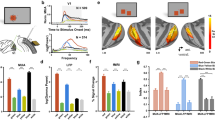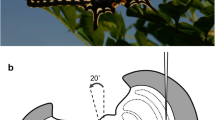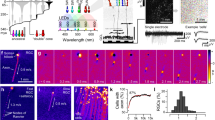Summary
We recorded from single neurons in the parvocellular layers of the lateral geniculate body of anesthetized monkeys. Spectral response curves of parvocellular neurons depended on the luminance ratio between the chromatic stimuli and achromatic background. From response/intensity curves, we determined the relative luminance between a coloured and an achromatic (white) light at which a given cell became non-responsive (critical luminance ratio, CLR). The spectral dependence of the CLRs of narrow (N) and wide band (W) cells with opponent receptor input showed characteristic differences. The activity of W-cells increased with luminance increase of a white light and of a coloured light in the specific spectral region of the cell (yellow-red for the long wave length sensitive WL-, and yellow-green-blue for the short wave length sensitive WS-cells), while N-cells were activated by their specific spectral light (blue for NS-cells, red for NL-cells) and by a luminance decrease of achromatic white. N-cells discriminate best between their characteristic colour and white at luminance ratios below their respective CLR, while W-cells distinguish best between a light of their characteristic colour and white at chromatic/ achromatic luminance ratios above their respective CLR. Yellow sensitive W-cells with a narrow spectral sensitivity peaking around 570 nm and with only a small or no response to white light, could enable distinction between white and yellow of similar luminance. The findings are consistent with the opponency model of spectrally sensitive cells in the LGB. We discuss their implications for colour coding by parvocellular cells. N- and W-cells appear to behave complementary with respect to luminance information (N-cells may be compared to the cat's off-cells, W-cells to on-cells). S- and L-cells are complementary with respect to colour. The yellow sensitive WM-cells are critical for the discrimination of yellow and white, while cells with excitatory cone input from blue and red cones (W-SL-cells) may aid the perception of purple. The fact that, at different relative luminance ratios between a chromatic stimulus and a white background, the whole family of parvocellular cells is involved differently in coding for colour, may explain the different appearance of colours against a white background at different luminance ratios and the perception of induced colours.
Similar content being viewed by others
References
Baumgartner G (1961) Die Reaktionen der Neurone des zentralen visuellen Systems der Katze im simultanen Helligkeitskontrast. In: Jung R, Kornhuber H (eds) Neurophysiologie und Psychophysik des visuellen Systems. Springer, Berlin Heidelberg New York, pp 296ff
Baumgartner G, Hakas P (1962) Die Neurophysiologie des simultanen Helligkeitskontrastes. Reziproke Reaktionen antagonistischer Neuronengruppen des visuellen Systems. Pflügers Arch Ges Physiol 274: 489–450
Boynton RM (1979) Human color vision. Holt, Rinehart and Winston, New York
Campenhausen C von (1968a) Über die Farben der Benhamschen Scheibe, Z Vergl Physiol 60: 351–374
Campenhausen C von (1968b) Über den Ursprungsort von musterinduzierten Flickerfarben im visuellen System des Menschen. Z Vergl Physiol 61: 355–360
Creutzfeldt O, Lee BB, Elepfandt A (1979) A quantitative study of chromatic organization and receptive fields of cells in the lateral geniculate body of the rhesus monkey. Exp Brain Res 35: 527–545
de Monasterio FM, Schein SJ (1982) Spectral band width of colour-opponent cells of geniculocortical pathway of macaque monkeys. J Neurophysiol 47: 214–224
Derrington A, Lennie P, Krauskopf J (1984) Chromatic mechanisms in lateral geniculate nucleus of macaque. J Physiol (Lond) 357: 241–265
De Valois RL (1973) Central mechanisms of colour vision. In: Jung R (ed) Handbook of sensory physiology, Vol VII/3, Central visual information, Part B. Springer, Berlin Heidelberg New York, pp 204–254
De Valois RL, Abramov I, Jacobs GI (1966) Analysis of response patterns of LGN cells. J Opt Soc Am 56: 966–977
De Valois RL, Marocco RT (1973) Single cell analysis of saturation discrimination in the macaque. Vision Res 13: 701–711
Dow BM (1974) Functional classes of cells and their laminar distribution in monkey visual cortex. J Neurophysiol 37: 927–946
Gouras P, Eggers H (1983) Responses of primate retinal ganglion cells to moving spectral contrast. Vision Res 23: 1175–1182
Hering E (1872–1874) Zur Lehre vom Lichtsinne. 6. Abhdl. Sitzungsberichte der Kgl. Akademie der Wissenschaften. Hof- und Staatsdruckerei, Wien
Hofmann K-D, Miescher K (1959) Experimentelle Bestimmung farbkräftigster Optimalfarben in Abhängigkeit vom Umfeld. 3mes Journées Internationales de la Couleur, Brüssel 1
Jameson D, Hurvich LM (1959) Perceived color and its dependence on focal, surrounding and preceding stimulus variables. J Opt Soc Am 49: 890–898
Jung R (1973) Visual perception and neurophysiology. Chap 1. In: Handbook of sensory physiology, Vol 7, Part 3A (Visual centers of the brain). Springer, Berlin Heidelberg New York
Krüger J (1977) Stimulus dependent colour specificity of monkey lateral geniculate neurones. Exp Brain Res 30: 297–311
Land EH (1974) The retinex theory of colour vision. Proc R Inst Gr Brit 47: 23–58
Lee BB, Virsu V (1983) The interaction of opponent cone mechanisms in cells of the macaque lateral geniculate nucleus. In: Mollon JD, Sharpe IT (eds) Colour vision: physiology and psychophysics. Academic Press, New York, pp 225–233
Marocco RT, De Valois RL (1977) Locus of spectral neutral point in monkey opponent cells depends on stimulus luminance relative to background. Brain Res 119: 465–470
Nothdurft Chr, Lee BB (1982) Responses to coloured patterns in the macaque lateral geniculate nucleus: pattern processing in single neurones. Exp Brain Res 48: 43–54
Ostwald W (1919) Die Farbenlehre, Vol 2. Unesma, Leipzig
Padmos P, Norren DV (1975) Cone systems interaction in single neurons of the lateral geniculate nucleus of the macaque. Vision Res 15: 617–619
Schiller P, Colby CL (1983) The responses of single cells in the lateral geniculate nucleus of the rhesus monkey to colour and luminance contrast. Vision Res 23: 1631–1641
Valberg A, Lee BB, Creutzfeldt OD, Tigwell DA (1983) Luminance ratio and the spectral responsiveness of cells in the macaque lateral geniculate nucleus. In: Mollon JD, Sharpe LT (eds) Colour vision: physiology and psychophysics. Academic Press, New York, pp 235–243
Valberg A, Lee BB, Tryti J (1985a) Computation of responses of opponent cells in the macaque lateral geniculate nucleus to light varying in luminance, wavelength and purity. University of Oslo, Institute of Physics Report Series, Report 85-29.
Valberg A, Lee BB, Tigwell D, Creutzfeldt O (1985b) A simultaneous contrast effect of remote surrounds on intensity-response curves of cells of the macaque LGN. Exp Brain Res 58: 604–608
Valberg A, Lee BB, Tigwell DA (1986) Neurons with strong inhibitory S-cone inputs in the macaque lateral geniculate nucleus. Vision Res (in press)
Virsu V, Lee BB (1983) Light adaptation in cells of macaque lateral geniculate nucleus and its relation to human light adaptation. J Neurophysiol 50: 864–878
Wiesel T, Hubel D (1966) Spatial and chromatic interactions in the lateral geniculate body of the rhesus monkey. J Neurophysiol 29: 1115–1156
Zrenner E, Gouras P (1983) Cone opponency in tonic ganglion cells and its variation with excentricity in rhesus monkey retina. In: Mollon JD, Sharpe IT (eds) Colour vision: physiology and psychophysics. Academic Press, New York, pp 211–223
Author information
Authors and Affiliations
Additional information
This work was supported by a NATO collaborative research grant to Dr. Arne Valberg (650/83)
Rights and permissions
About this article
Cite this article
Creutzfeldt, O., Lee, B.B. & Valberg, A. Colour and brightness signals of parvocellular lateral geniculate neurons. Exp Brain Res 63, 21–34 (1986). https://doi.org/10.1007/BF00235643
Received:
Accepted:
Issue Date:
DOI: https://doi.org/10.1007/BF00235643




